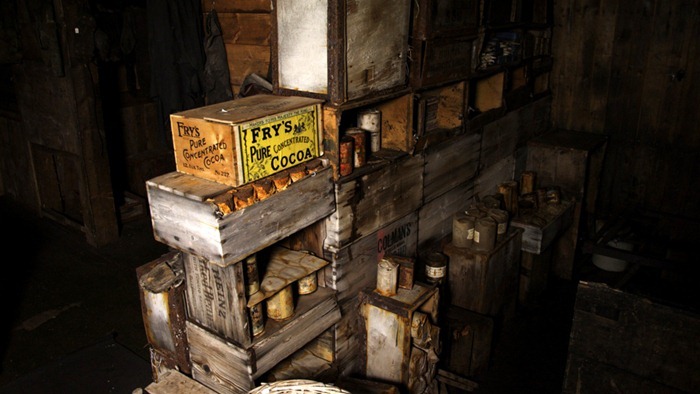Robert Falcon Scott’s hut is located on the north shore of Cape Evans on Ross Island in Antarctica. It was erected in 1911 by the ill-fated British Antarctic Expedition of 1910–1913, also known as the Terra Nova Expedition. Scott led a party of five which reached the South Pole on 17 January 1912, only to find that they had been preceded by Roald Amundsen's Norwegian expedition. On their return journey, Scott and his four comrades all perished from a combination of exhaustion, starvation and extreme cold. His hut survived.
After 1917 the hut remained untouched until 1956 when US expeditioners dug it out of the snow and ice. It was found to be in a remarkable state of preservation, and included many artifacts from both the earlier expeditions. While some artifacts were taken as souvenirs at the time (and since), this hut remained largely as it was in 1917.
While food are largely preserved due to the freezing temperatures and dry climate, bacterial decay still occurs. Visitors describe the seal meat preserved at the Scott’s Hut as smelling 'quite rancid', and there are concerns that the fabric of these huts are being affected by fungal decay. The Antarctic Heritage Trust is mid-way through a six-year project to conserve the hut and all of its contents. The building itself, once at risk of collapse, has been conserved and weatherproofed, and experts are now cleaning and repairing each item inside it. Both Scott's Hut and Shackleton's Hut have been included on the World Monuments Watch List of 100 Most Endangered Sites.
Scott's Hut was prefabricated in England before being brought south by ship. It is rectangular, 50 feet long and 25 feet wide. Insulation was provided by seaweed sewn into a quilt, placed between double-planked inner and outer walls. The roof was a sandwich of three layers of plank and 2 layers of rubber ply enclosing more quilted seaweed. Lighting was provided by acetylene gas, and heating came from the kitchen and a supplementary stove using coal as fuel. Considerable effort was made to insulate the building, and to extract the maximum amount of heat from the flues from the stove and the heater. In fact, the hut was so warm that the Terra Nova expeditioners described it as being warm to the point of being uncomfortable!
Apart from Scott himself, the only member of the 25-man team with his own space was expedition photographer Herbert Ponting, whose darkroom-cum-bedroom is still intact. Scott was the first explorer to realize the importance of photography in wooing the newly emerging newspaper industry.
Scott also pioneered the idea of expedition sponsorship. Many companies, such as Bovril and Huntley & Palmers, made special supplies for the expedition, providing them free in exchange for publicity.
Meals served in the hut were substantial, and could run to several courses. Scott believed that the men needed good meals to help them cope with the hardships. However, when they went on trips off-base they burned more calories than they consumed - the need for extra nutrition at high altitude was not understood.
The food included the finer things that the gentlemen of the expedition would have been used to. However, cook Thomas Clissold occasionally improvised with seals and penguins.
Medicine bottles can be seen on a shelf above one of the beds. Liquorice Compound Powder (far right) was used to soothe upset stomachs.

A wall of boxes stands 6ft (1.8m) high and runs along the width of the hut. "I found Barrows making cubicles, so instructed him to build a bulkhead of cases which shuts off the officers' space from the men's. I am quite sure to the satisfaction of both," Scott wrote in his diary.
The expedition also boasted the most comprehensive Antarctic scientific study of its day. Eleven scientists measured the landscape, mapped skies, studied the climate and returned discoveries for analysis at home... including the eggs of the Emperor Penguin.
Newspapers and books are still scattered around the hut. Based in the hut for two years, the men treasured anything they could read.
Scott sat at a desk in front of his bed to record the daily events of the British Antarctic Expedition. He kept a detailed diary right up to his last day in a frozen tent on the ice shelf where he died, aged 43, from a combination of starvation, exhaustion and extreme weather conditions.
Sources: BBC, Wikipedia. Hundreds of more pictures at Flickr























Very brave men.
ReplyDeleteI have been to both of these huts and the hut pictured is known as Discovery Hut, located on Cape Evans, Antarctica. What's known as Scotts Hut is located at Hut Point, McMurdo Station, Antarctica.
ReplyDelete